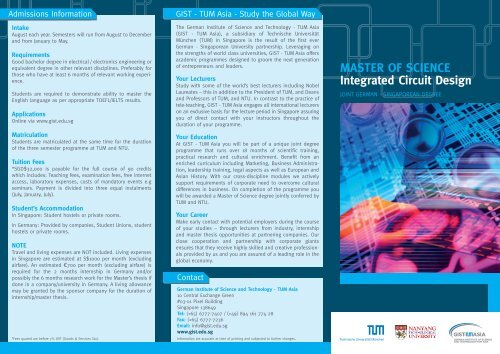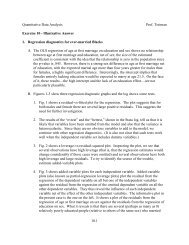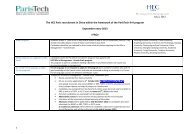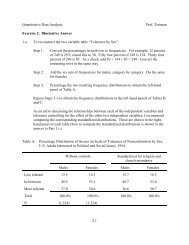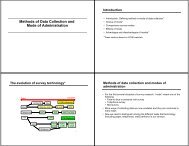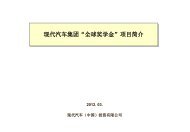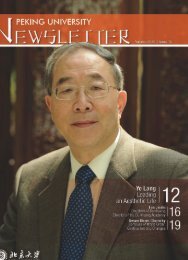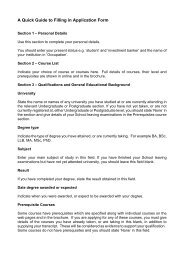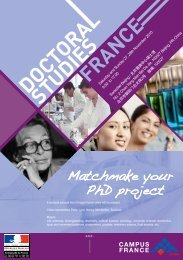MASTER OF SCIENCE Integrated Circuit Design
MASTER OF SCIENCE Integrated Circuit Design
MASTER OF SCIENCE Integrated Circuit Design
- No tags were found...
Create successful ePaper yourself
Turn your PDF publications into a flip-book with our unique Google optimized e-Paper software.
Admissions Information<br />
Intake<br />
August each year. Semesters will run from August to December<br />
and from January to May.<br />
Requirements<br />
Good bachelor degree in electrical / electronics engineering or<br />
equivalent degree in other relevant disciplines. Preferably for<br />
those who have at least 6 months of relevant working experience.<br />
Students are required to demonstrate ability to master the<br />
English language as per appropriate TOEFL/IELTS results.<br />
Applications<br />
Online via www.gist.edu.sg<br />
Matriculation<br />
Students are matriculated at the same time for the duration<br />
of the three semester programme at TUM and NTU.<br />
Tuition Fees<br />
*SGD$32,000 is payable for the full course of 90 credits<br />
which includes: Teaching fees, examination fees, free internet<br />
access, laboratory expenses, costs of mandatory events e.g<br />
seminars. Payment is divided into three equal instalments<br />
(July, January, July).<br />
Student’s Accommodation<br />
In Singapore: Student hostels or private rooms.<br />
In Germany: Provided by companies, Student Unions, student<br />
hostels or private rooms.<br />
NOTE<br />
Travel and living expenses are NOT included. Living expenses<br />
in Singapore are estimated at S$1000 per month (excluding<br />
airfare). An estimated €700 per month (excluding airfare) is<br />
required for the 2 months internship in Germany and/or<br />
possibly the 6 months research work for the Master’s thesis if<br />
done in a company/university in Germany. A living allowance<br />
may be granted by the sponsor company for the duration of<br />
internship/master thesis.<br />
*Fees quoted are before 7% GST (Goods & Services Tax).<br />
GIST - TUM Asia - Study the Global Way<br />
The German Institute of Science and Technology - TUM Asia<br />
(GIST - TUM Asia), a subsidiary of Technische Universität<br />
München (TUM) in Singapore is the result of the first ever<br />
German - Singaporean University partnership. Leveraging on<br />
the strengths of world class universities, GIST - TUM Asia offers<br />
academic programmes designed to groom the next generation<br />
of entrepreneurs and leaders.<br />
Your Lecturers<br />
Study with some of the world’s best lecturers including Nobel<br />
Laureates – this in addition to the President of TUM, and Deans<br />
and Professors of TUM, and NTU. In contrast to the practice of<br />
tele-teaching, GIST - TUM Asia engages all international lecturers<br />
on an exclusive basis for the lecture period in Singapore assuring<br />
you of direct contact with your instructors throughout the<br />
duration of your programme.<br />
Your Education<br />
At GIST - TUM Asia you will be part of a unique joint degree<br />
programme that runs over 18 months of scientific training,<br />
practical research and cultural enrichment. Benefit from an<br />
enriched curriculum including Marketing, Business Administration,<br />
leadership training, legal aspects as well as European and<br />
Asian History. With our cross-discipline modules we actively<br />
support requirements of corporate need to overcome cultural<br />
differences in business. On completion of the programme you<br />
will be awarded a Master of Science degree jointly conferred by<br />
TUM and NTU.<br />
Your Career<br />
Make early contact with potential employers during the course<br />
of your studies – through lecturers from industry, internship<br />
and master thesis opportunities at partnering companies. Our<br />
close cooperation and partnership with corporate giants<br />
ensures that they receive highly skilled and creative professionals<br />
provided by us and you are assured of a leading role in the<br />
global economy.<br />
Contact<br />
German Institute of Science and Technology - TUM Asia<br />
10 Central Exchange Green<br />
#03-01 Pixel Building<br />
Singapore 138649<br />
Tel: (+65) 6777-7407 / (+49) 894 161 774 28<br />
Fax: (+65) 6777-7236<br />
Email: info@gist.edu.sg<br />
www.gist.edu.sg<br />
Information are accurate at time of printing and subjected to further changes.<br />
<strong>MASTER</strong> <strong>OF</strong> <strong>SCIENCE</strong><br />
<strong>Integrated</strong> <strong>Circuit</strong> <strong>Design</strong><br />
JOINT GERMAN - SINGAPOREAN DEGREE
Overview<br />
GIST - TUM Asia’s Master of Science in <strong>Integrated</strong> <strong>Circuit</strong> <strong>Design</strong><br />
equips students with the academic proficiency and hands-on<br />
knowledge required in the design, development and manufacture<br />
of integrated circuit or integrated electrionic products. The<br />
Master degree is jointly awarded by two of the world’s<br />
reputable universities: Technische Universität München (TUM),<br />
Nanyang Technological University.<br />
Programme Structure and Duration<br />
The Master of Science in <strong>Integrated</strong> <strong>Circuit</strong> <strong>Design</strong> is a full time<br />
research and application focused programme that runs over 18<br />
months (3 semesters). Students will complete 12 modules in<br />
semester 1 and 2 in IC <strong>Design</strong> topics including 6 core modules<br />
and 4 elective modules and 2 laboratory modules. Each technical<br />
module has 45 contact hours. In addition, students will<br />
take an English module of 80 hours and 5 other non-technical<br />
short modules of 10 hours each. Students are also required to<br />
complete a master thesis to be carried out for the full semester<br />
3. The thesis may be undertaken either at NTU, TUM or in a<br />
company.<br />
Core Modules<br />
• System-on-chip Solutions and Architecture<br />
• <strong>Design</strong> Methodology and Automation<br />
• Mixed Signal <strong>Circuit</strong> <strong>Design</strong><br />
• Digital IC <strong>Design</strong><br />
• Analog IC <strong>Design</strong><br />
• Digital Signal Processing<br />
• Laboratory 1 : Analog IC <strong>Design</strong><br />
• Laboratory 2 : Digital IC <strong>Design</strong><br />
• Business and Technical English<br />
*Elective Modules (Select 4)<br />
• <strong>Design</strong> for Testability of VLSI<br />
• Nanoelectronics<br />
• Advanced MOSFETs and Novel Devices<br />
• RF IC <strong>Design</strong><br />
• Simulation and Optimization of Analog <strong>Circuit</strong>s<br />
• Embedded Systems<br />
• IC Packaging<br />
*Subject to additions/modifications<br />
Cross Discipline Modules (Compulsory)<br />
• International Intellectual Property Law<br />
• Selected Topics in Business and Adminstration<br />
• Selected Topics in Management Methods<br />
• Cultural, Social and Economic Aspects of Globalization<br />
• Aspects of European and Asian History and Culture<br />
Subject Contents<br />
Core Modules<br />
System on chip solutions and Architecture<br />
Basics of CMOS integrated circuits from a system's perspective,<br />
from MOSFET Transistor to realization of combinational /<br />
sequential logic, Finite State Machines (FSM), SRAM, DRAM,<br />
FLASH, FPGA, CPU core building blocks. Projection of IC<br />
technology scaling and implementation alternative, <strong>Integrated</strong><br />
system solutions in inter-networking and communications:<br />
SONET / SDH transport framers, Ethernet LAN/ATM SAN<br />
switches, Control point processors and communication controllers,<br />
network processers.<br />
<strong>Design</strong> Methodology and Automation<br />
Computer-aided design of analog and digital integrated<br />
circuits. VLSI design flow. System level, algorithmic level,<br />
register transfer level, logic level, circuit level. VLSI design<br />
methods, high-level synthesis, logic synthesi, layout sysnthesis.<br />
Analog and digital simulation, test design, formal verification.<br />
Techniques from discrete mathematics and computer<br />
science.<br />
Mixed Signal <strong>Circuit</strong> <strong>Design</strong><br />
Fundamentals of discrete time signal processing. MOSFET as a<br />
switch. Sample & hold circuits, switched capacitor circuits.<br />
Data converter fundamentals. Nyquist rate D/A / AD converters.<br />
Over sampling, noise shaping, A/D and D/A converters using<br />
sigma-delts modulators. Switched capacitor filters.<br />
Digital IC <strong>Design</strong><br />
Review of <strong>Integrated</strong> circuit fundamentals. Layout and design<br />
issues. CMOS Digital <strong>Circuit</strong>s. BiCMOS Digital <strong>Circuit</strong>s. Sub<br />
system design in digital circuits. <strong>Design</strong> methodologies.<br />
Analog IC <strong>Design</strong><br />
Review of fundamentals. Analog building blocks. Switched<br />
capacitor circuits. Current mode circuits. Continuous-time<br />
filters. Data converters.<br />
Digital Signal Processing<br />
Introduction . Discrete-Fourier Transform (DFT) and Fast Fourier<br />
Transform (FFT). Z Transform. Digital filters. Linear prediction<br />
and optimum linear filters. Power spectrum estimation.<br />
Elective Modules<br />
<strong>Design</strong> for Testability of VLSI<br />
Fault models and testability concepts. Test generation and fault<br />
simulation algorithms. Introduction to testable design. Test<br />
response compression. Shift-register polynomial division.<br />
Pseudo-random sequence generators. Special purpose<br />
shift-register circuits. Random pattern BIST. Built in boundary<br />
scan structure. Limitaions and other concerns of random<br />
pattern test. Test techniques for automatic test equipment.<br />
Nanoelectronics<br />
Low dimensional structures: quantum wells, quantum wires<br />
and quantum dots. Electronic, optical, transport properties<br />
of nanostructures. Quantum semiconductor devices. Fabrication<br />
and charaterization techniques of nanatechnology.<br />
Applications of nanostructures, nanodevices and nanosystems.<br />
The bottom-up approach to nanotechnology: introduction<br />
to molecular electronics and optoelectronics. Organic<br />
materials for electronics: self – assembled monolayers;<br />
conducting polymers;carbon nanotubes. <strong>Circuit</strong> implementations<br />
and architectures for nanostructures; quantum cellular<br />
automata and cellular non linear networks. Introduction to<br />
quantum computing.<br />
Advanced MOSFETs and Novel Devices<br />
Historical development of mainstream MOSFETs until today:<br />
economical, technological and physical fundamentals.<br />
Properties of long channel and short channel MOSFETs. Hot<br />
carrier effects, scaling rules, basic of charge carrier transport<br />
(quantum-mechanical, hydro-dynamics, ballitics). Proposed<br />
new MOSFET structures (vertical MOSFETs, double–gate,<br />
fully-depleted MOSFETs). Hot-electron transistors, tunnelling<br />
transisteors, lov-dimensional devices, singleelectrontransistor,<br />
single-electron memories, quantumelectronics.<br />
RF IC <strong>Design</strong><br />
System design considerations. CMOS RF components and<br />
devices. Low-Noise Amplifier (LNA); Mixers; Voltage-<br />
Controlled Oscillators (VCOs) RF power amplifiers. Phaselocked<br />
loops and frequency synthesizers.<br />
Simulation and Optimization of Analog <strong>Circuit</strong>s<br />
Analog simulation. AC (small-signal) simulation. DC<br />
(operating point) simulation. TR (transient) simulation.<br />
Large-signal models. Analog optimization. <strong>Design</strong> centering.<br />
Probability calculus. Optimality conditions constrained/<br />
unconstrained. Univariate optimization. Constrained optimization.<br />
Sequential quadratic programming. Linear programming.<br />
Statistical optimization.<br />
Embedded Systems<br />
Compositional Timing Analysis, Worst-Case Execution Time<br />
(WCET) Analysis, Realtime Programming Language<br />
(Esterel,Lustre), Microprocessor Architecture (RISC Vs DSP,<br />
VLIW, SIMD, FPGAs), Software Platforms, Tools for Host-<br />
Target-Development, Monitoring and Debugging,<br />
Simulation& <strong>Design</strong> Space Exploration, RTOS and Scheduling<br />
Policies, Processor Clock Rate, Benchmarking, Memory<br />
Hierarchy (Cache)<br />
IC Packaging<br />
IC Packaging Overview, Electrical Packaging <strong>Design</strong> and<br />
Thermal Management, Single Chip and Multichip Packaging,<br />
IC Assembly, Sealing and Encapsulation, IC Packaging Failure<br />
and Reliability, Microsystems Packaging and Applications.


